STS-36
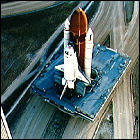 Space Shuttle Atlantis lifts off on a four-day Department of Defense mission, the specifics of which remain classified. The crew consists of Commander John Creighton, Pilot John Casper, and mission specialists Richard Mullane, David Hilmers and Pierre Thuot.
Space Shuttle Atlantis lifts off on a four-day Department of Defense mission, the specifics of which remain classified. The crew consists of Commander John Creighton, Pilot John Casper, and mission specialists Richard Mullane, David Hilmers and Pierre Thuot.
STS-34
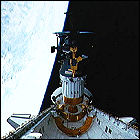 Space Shuttle Atlantis lifts off on a mission lasting nearly five days, whose primary goal is to lift the interplanetary probe Galileo into orbit. Originally intended for launch in late 1982, Galileo is bound for Jupiter by way of a long, looping trajectory that sends it to Venus and back to Earth multiple times, picking up speed via gravitational assist with each visit. Galileo won’t actually reach Jupiter itself until December 1995. Aboard Atlantis for this flight are Commander Donald Williams, Pilot Michael McCulley, and mission specialists Franklin Chang-Diaz, Shannon Lucid, and Ellen S. Baker.
Space Shuttle Atlantis lifts off on a mission lasting nearly five days, whose primary goal is to lift the interplanetary probe Galileo into orbit. Originally intended for launch in late 1982, Galileo is bound for Jupiter by way of a long, looping trajectory that sends it to Venus and back to Earth multiple times, picking up speed via gravitational assist with each visit. Galileo won’t actually reach Jupiter itself until December 1995. Aboard Atlantis for this flight are Commander Donald Williams, Pilot Michael McCulley, and mission specialists Franklin Chang-Diaz, Shannon Lucid, and Ellen S. Baker.
The People vs. Galileo?
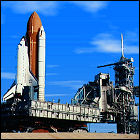 A lawsuit, filed by environmental activists worried about the release of plutonium from the Galileo Jupiter probe’s radioisotope thermoelectric generators in the event of a Challenger-like disaster during launch, is dismissed by a federal judge; the President of the United States has also given permission for the launch to proceed (a requirement anytime a nuclear-fueled spacecraft is in the works). The suit, filed earlier in the year, sought an injunction to prevent Galileo from being launched. Times have changed since the last RTG-powered flight (the Voyager missions of the 1970s), and activists are concerned about a Chernobyl-style radioactive disaster, although the plutonium 238 at the heart of Galileo’s power supply (and that of other interplanetary probes that have used it) is non-weapons-grade and non-fissible. Galileo is slated to be launched in a week aboard the space shuttle Atlantis.
A lawsuit, filed by environmental activists worried about the release of plutonium from the Galileo Jupiter probe’s radioisotope thermoelectric generators in the event of a Challenger-like disaster during launch, is dismissed by a federal judge; the President of the United States has also given permission for the launch to proceed (a requirement anytime a nuclear-fueled spacecraft is in the works). The suit, filed earlier in the year, sought an injunction to prevent Galileo from being launched. Times have changed since the last RTG-powered flight (the Voyager missions of the 1970s), and activists are concerned about a Chernobyl-style radioactive disaster, although the plutonium 238 at the heart of Galileo’s power supply (and that of other interplanetary probes that have used it) is non-weapons-grade and non-fissible. Galileo is slated to be launched in a week aboard the space shuttle Atlantis.
STS-30
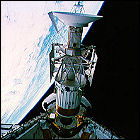 Space Shuttle Atlantis lifts off on a four-day mission to launch the long-delayed interplanetary probe Magellan, which is sent to Venus via an Interial Upper Stage booster module. For the first time, one of a shuttle’s five onboard computers fails and is replaced in an in-orbit repair procedure. Aboard Atlantis for this flight are Commander David Walker, Pilot Ronald Grabe, and mission specialists Norm Thagard, Mary Cleave and Mark Lee. The launch of Magellan, a mission originally conceived in 1972, marks the beginning of the first American interplanetary mission since 1977.
Space Shuttle Atlantis lifts off on a four-day mission to launch the long-delayed interplanetary probe Magellan, which is sent to Venus via an Interial Upper Stage booster module. For the first time, one of a shuttle’s five onboard computers fails and is replaced in an in-orbit repair procedure. Aboard Atlantis for this flight are Commander David Walker, Pilot Ronald Grabe, and mission specialists Norm Thagard, Mary Cleave and Mark Lee. The launch of Magellan, a mission originally conceived in 1972, marks the beginning of the first American interplanetary mission since 1977.
Damaged goods: Atlantis returns
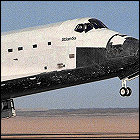 Space Shuttle Atlantis returns to Earth from a classified four-day mission to deploy a payload for the Department of Defense, and on only the second flight since the Challenger disaster, most of Atlantis’ crew are surprised to return to Earth at all. During the mission, they note that Atlantis is missing numerous heat shield tiles along the vehicle’s right side and its wing – a post-landing damage survey counts over 700 missing tiles, making Atlantis the most-damaged orbiter to return safely from space. The damage had been pointed out to ground controllers by the crew, but when NASA asks permission from the Defense Department to allow the crew to send a live TV signal to Earth so engineers can survey the damage in orbit, that permission is refused. A slow-scan encrypted video system is used instead, and its low resolution doesn’t reveal the extent of the damage. The damage is believed to have been caused by insulation vibrating loose from the solid rocket booster and the external fuel tank and striking the shuttle during launch, an almost identical cause of damage that proves catastrophic to another shuttle 15 years later.
Space Shuttle Atlantis returns to Earth from a classified four-day mission to deploy a payload for the Department of Defense, and on only the second flight since the Challenger disaster, most of Atlantis’ crew are surprised to return to Earth at all. During the mission, they note that Atlantis is missing numerous heat shield tiles along the vehicle’s right side and its wing – a post-landing damage survey counts over 700 missing tiles, making Atlantis the most-damaged orbiter to return safely from space. The damage had been pointed out to ground controllers by the crew, but when NASA asks permission from the Defense Department to allow the crew to send a live TV signal to Earth so engineers can survey the damage in orbit, that permission is refused. A slow-scan encrypted video system is used instead, and its low resolution doesn’t reveal the extent of the damage. The damage is believed to have been caused by insulation vibrating loose from the solid rocket booster and the external fuel tank and striking the shuttle during launch, an almost identical cause of damage that proves catastrophic to another shuttle 15 years later.
STS-27
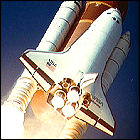 Space Shuttle Atlantis lifts off on the 27th shuttle flight, a four-day mission to launch a classified Defense Department payload. The crew aboard Atlantis for this flight consists of Commander Robert Gibson, Pilot Guy Gardner, and mission specialists Richard Mullane, Jerry Ross, and William Shepherd. All other information about this flight, including launch weight and even Atlantis’ orbital altitude, remain classified to this day.
Space Shuttle Atlantis lifts off on the 27th shuttle flight, a four-day mission to launch a classified Defense Department payload. The crew aboard Atlantis for this flight consists of Commander Robert Gibson, Pilot Guy Gardner, and mission specialists Richard Mullane, Jerry Ross, and William Shepherd. All other information about this flight, including launch weight and even Atlantis’ orbital altitude, remain classified to this day.
STS-61B
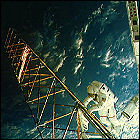 Space Shuttle Atlantis lifts off on a seven-day mission of crucial importance to plans for a future space station. In addition to launching three satellites (Mexico’s MORELOS-B, RCA’s SATCOM KU-2 and AUSSAT-2 for Australia), two spacewalks in excess of five hours each are conducted, each one testing a different method of erecting large truss structures in space. Atlantis’ crew for this mission consists of Commander Brewster Shaw, Pilot Bryan O’Connor, mission specialists Mary Cleave, Sherwood Spring, Jerry Ross and payload specialists Rodolfo Neri Vela and Charles Walker.
Space Shuttle Atlantis lifts off on a seven-day mission of crucial importance to plans for a future space station. In addition to launching three satellites (Mexico’s MORELOS-B, RCA’s SATCOM KU-2 and AUSSAT-2 for Australia), two spacewalks in excess of five hours each are conducted, each one testing a different method of erecting large truss structures in space. Atlantis’ crew for this mission consists of Commander Brewster Shaw, Pilot Bryan O’Connor, mission specialists Mary Cleave, Sherwood Spring, Jerry Ross and payload specialists Rodolfo Neri Vela and Charles Walker.
STS-51J: the first flight of Atlantis
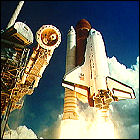 The inaugural flight of Space Shuttle Atlantis takes the newest orbiter on a four-day Defense Department mission (the specifics of which remain classified). Manning Atlantis for this flight are Commander Karol Bobko, Pilot Ronald Grabe, and mission specialists David Hilmers, Robert Stewart and William Pailes.
The inaugural flight of Space Shuttle Atlantis takes the newest orbiter on a four-day Defense Department mission (the specifics of which remain classified). Manning Atlantis for this flight are Commander Karol Bobko, Pilot Ronald Grabe, and mission specialists David Hilmers, Robert Stewart and William Pailes.
Atlantis complete
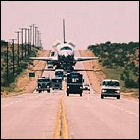 After four years of construction and an additional year of testing and checkout, the Space Shuttle Atlantis rolls out of the Rockwell International facility at Palmdale, California – the last of the current space shuttle fleet, to the best of anyone’s knowledge at the time. Over three tons lighter than Columbia, Atlantis doesn’t have long to wait for her first mission, lifting off for the first time in October 1985.
After four years of construction and an additional year of testing and checkout, the Space Shuttle Atlantis rolls out of the Rockwell International facility at Palmdale, California – the last of the current space shuttle fleet, to the best of anyone’s knowledge at the time. Over three tons lighter than Columbia, Atlantis doesn’t have long to wait for her first mission, lifting off for the first time in October 1985.
Atlantis under construction
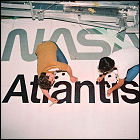 Construction begins on what is intended to be the fourth and final member of the current Space Shuttle fleet, Atlantis. With four orbiters in service, NASA will be one step closer to the routine, almost-weekly schedule of orbital flights envisioned in the Nixon-era mandate for the shuttle. Refinements and improvements in the process of constructing the shuttle fleet make Atlantis the lightest shuttle to date, over three tons lighter than Columbia.
Construction begins on what is intended to be the fourth and final member of the current Space Shuttle fleet, Atlantis. With four orbiters in service, NASA will be one step closer to the routine, almost-weekly schedule of orbital flights envisioned in the Nixon-era mandate for the shuttle. Refinements and improvements in the process of constructing the shuttle fleet make Atlantis the lightest shuttle to date, over three tons lighter than Columbia.
Christening the fleet
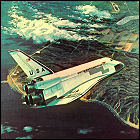 After several years of referring to the various Space Shuttle orbiters both under construction and in planning by numbers, NASA bestows names upon the anticipated fleet of four orbiters. OV-102, which is still expected to fly “late this year”, is named Columbia, while OV-099, undergoing conversion from a test article to flight-worthy vehicle, is named Challenger. Orbiters 103 and 104 will be named, respectively, Discovery and Atlantis; all four names are drawn from historical seafaring exploration vessels. (NASA has also used some of the names before: Columbia was the name of the moon-orbiting command module in the Apollo 11 mission, while Apollo 17’s lunar lander was named Challenger.)
After several years of referring to the various Space Shuttle orbiters both under construction and in planning by numbers, NASA bestows names upon the anticipated fleet of four orbiters. OV-102, which is still expected to fly “late this year”, is named Columbia, while OV-099, undergoing conversion from a test article to flight-worthy vehicle, is named Challenger. Orbiters 103 and 104 will be named, respectively, Discovery and Atlantis; all four names are drawn from historical seafaring exploration vessels. (NASA has also used some of the names before: Columbia was the name of the moon-orbiting command module in the Apollo 11 mission, while Apollo 17’s lunar lander was named Challenger.)